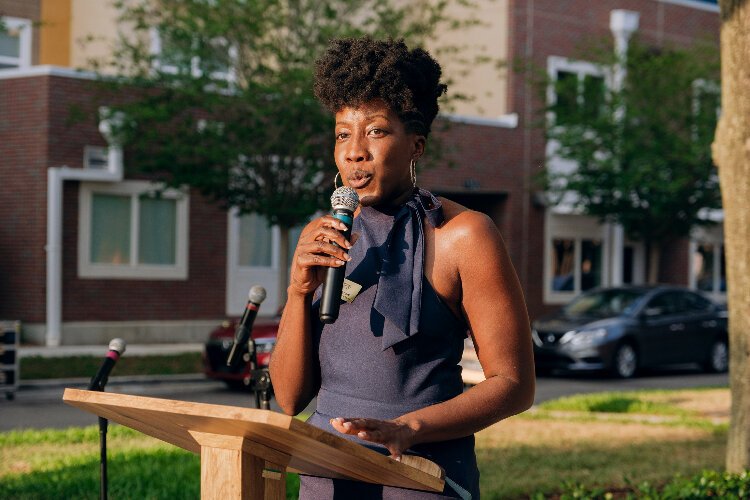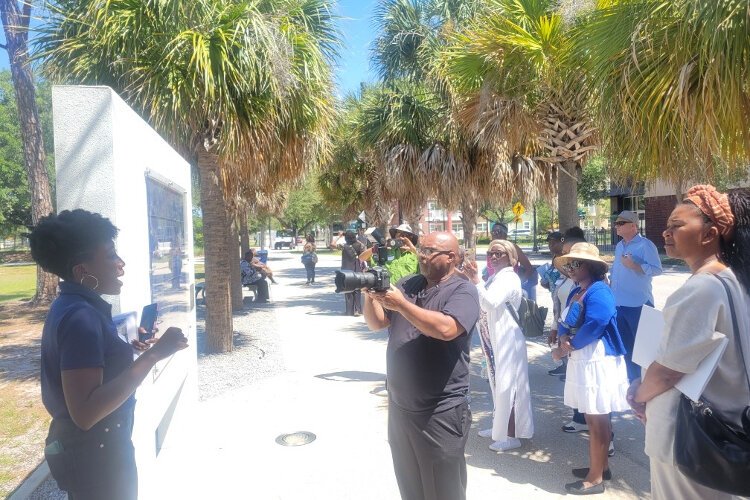Ashley Morrow: Shining a light on Tampa’s Black history
When riots broke out in Tampa on Memorial Day weekend 2020 following the murder of George Floyd by a Minneapolis police officer, Ashley Morrow grabbed her camera and documented the scene. Now, Morrow explores and spotlights Tampa's deep but often overlooked Black History as the Tampa Bay History Center's program manager for St. James at ENCORE.
The story of Tampa Bay runs deep in Ashley Morrow’s veins. She speaks proudly of being a fifth-generation Tampanian and the legacy of service that runs in her family.
The Morrow men, Ashley’s father, brothers and uncles, have all been Hillsborough County firefighters.
“I was the black sheep,” she says. “I wanted to be a photographer.”
On Memorial Day weekend 2020, riots broke out in Tampa in response to the killing of George Floyd by a Minneapolis police officer later convicted of murder in Floyd’s death. Buildings were set on fire and stores looted.
Morrow grabbed her camera and documented the scene. Those events made her a professional photographer and inspired her to look behind the anger into local Black history.
“I wanted to know, ‘What are they fighting for, what do they want to accomplish?’” she says.
Tracing her family story
Morrow started with her own family’s story. She discovered that a great-uncle was a member of the White Hats, the group of young men that Black community leaders recruited during the Tampa riots of 1967 to help keep the peace after the killing by Tampa police of an unarmed 19-year-old Black man, Martin Chambers. That level of activism and dedication inspired Morrow.
“I discovered the White Hats went to Washington D.C. to speak with President Kennedy about job reforms,” she says. “Back home, they focused on youth opportunities and advancement. I discovered that newspaper archives were a treasure trove. I now encourage people who are researching their family histories to use that free resource.”
From there, Morrow started helping other families uncover their history.
“Some of the people I first helped were my classmates,” she says. “I was able to reveal history they didn’t know. Some of them were descendants of great pioneers.”
“I was fortunate to meet Ersula Odom who owns and runs Ersula’s History Shop, a memorabilia and history book shop at 1421 Tampa Park Plaza,” Morrow says. “Ersula is so knowledgeable about Tampa’s Black history. She’s been a wonderful friend and mentor. I’m now a total history nerd.”
Tampa’s rich Black history
The quest to uncover and document Black history in Tampa is not a solo one. Others have contributed research that revealed inspiring stories of courage and resourcefulness.
There’s the story of nurse Clara Fry, who started a Tampa medical facility for African Americans on Lamar Street in the early 1900s. The City of Tampa purchased the facility in 1928 and named it the Tampa Negro Hospital. Fry continued to work there until her retirement. In 1937, the City of Tampa opened a new, 62-bed hospital for African Americans on Union Street – the Clara Frye Memorial Hospital.
In 1870, five years after the end of slavery, a Black militia formed in the predominantly African American neighborhood known as “The Scrub.” The neighborhood’s main street, Central Avenue, was later known as the Harlem of the South. The Scrub’s Black militia boasted a muster roll of 94. Its primary purpose was to be a protection force, Morrow explains. Emotions were raw in the years after emancipation and other Black communities faced harassment and violence. Eventually, the militia also exerted political influence on behalf of the citizens it protected.
St. James at ENCORE
As Morrow recounts stories, the excitement in her voice is evident. The saying, “Love what you do and you’ll never work a day in your life,” comes to mind.
The work Morrow loves is her role as program manager at St. James at ENCORE, a partnership between the Tampa Bay History Center and the Tampa Housing Authority that provides educational and cultural experiences and programming at the historic St. James Episcopal Church in the Housing Authority’s ENCORE district.
St. James Church is a long-time landmark in the Black community. The Tampa Housing Authority has restored the church building and the History Center now hosts programs on Black history there. The church building also houses Morrow’s office. From there, she launches initiatives like a newly formed group called the Black Tampa Historians. She also leads the History Center’s monthly walking tour of the Central Avenue district, including landmarks like St. James Church and Perry Harvey Sr. Park.
Morrow also engages the community through initiatives like the Black History Book Club, which meets every other month at St. James at ENCORE. For 2024, there are meetings on the last Monday of June, August and October, and the second Monday of December. Morrow describes the meetings as a chance for reflection, connection and community engagement. Morrow and Tampa Bay History Center Curator of Black History Fred Hearns lead the group discussions. Eventually, Morrow hopes St. James at ENCORE will be home to a Black History Museum.
In just a few years, Morrow has established herself as one of Tampa Bay’s preeminent Black historians. When asked what she wishes most to ultimately accomplish, she replies, “Empowerment.”
“I want people to know their history and to feel empowered by that knowledge,” Morrow says. “Look at your own family, dig deep into your roots, talk to your grandparents, aunts and uncles. Be proud of where you come from.”
Upcoming events
On June 19th, the Tampa Bay History Center and St. James at ENCORE celebrate Juneteenth with a Fabric of Freedom Fashion Show that will feature the evolution of Black fashion through the decades, from church whites to the heyday of the Cotton Club, through the civil rights era. The event starts at 5:30 p.m. and tickets are $35. For more information on the Juneteenth event and tickets, go to Fabric of Fashion.
Morrow will also lead Tampa Bay History Center Walking Tours of the historic Central Avenue district, once known as the “Harlem of the South,” on June 7th, July 12th, August 2nd, September 6th, October 4th, November 1st and December 6th. For more information, go to Tampa Bay History Center Walking Tours.















